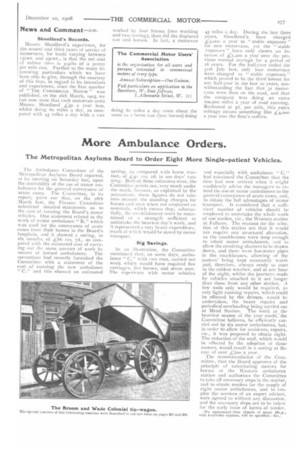More Ambulance Orders.
Page 11

If you've noticed an error in this article please click here to report it so we can fix it.
The Metropolitan Asylums Board to Order Eight More Single-patient Vehicles.
The Ambulance Committee of the Nfeiropolitan Asylums Board reported, at its meeting on Saturday last, upon the desirability of the use of motor ambulances for the general conveyance of acute cases. The Committee, in its report, point out that, on the 28th March last, the Finance Committee submitted detailed statements as to the cost of running the Board's motor vehkles. One statement related to the work of motor ambulance " B," which was used for the conveyance of acute cases from their homes to the Board's hospitals, and it showed a saving, in six months, of T2S. 7d., as compared with the estimated cost of carrying out the same amount of work by means ol horsed ambulances. The accountant had recently furnished the Committee with a statement of the cost of running the new ambulance " C," and this ehowed an estimated saving, as compared with horse traction, of .4:41 12S. 2d. ill 100 days' running. Both of these estimates were, the Conunittve points out, very much under the mark, because, as explained by the accountant. these figures do not take into account the standing charges for horses and men when not employed on removals, which means that, substantially, the establishment must be maintained at a strength sufficient to undertake the heaviest day's work, and it represented a very heavy expenditure, much of ‘vhich would he saved by motor transport.
Big Savings.
As an illustration, the Committee mentioned that, on some days, ambulance " C," with two men, carried out work which would have required five carriages, five horses, and seven men. The experience with motor vehicles
• ind especially with ambulance " C." had convinced the Committee that the time had now arrived when it tnight confidently advise the managers to extend the use of motor ambulances to the general conveyance of acute cases, and, to obtain the full advantages of motor transport. It considered that a sufficient number of vehicles should be employed to undertake the whole work of one station, viz., the Western citation at Fulham. The reasons for the selection of this station are that it would not require any structural alteration, as the coachhouses were deep enough to admit motor ambulances, and to. allow the revolving shutters to be drawn down, and there were hot-water pipes in the coachhouses, allowing of the motors' being kept constantly warm and, therefore, always ready to start in the coldest weather, and at any hour of the night, whilst the journeys made by vehicles attached to it are longer than those from any other station. A few tools only would be required, as only light running repairs, which could be effected by the drivers, would be undertaken, the heavy repairs and periodical overhauling being carried out at Mead Station. The work at the heaviest season of the year could,the Committee believes, be efficiently carried out by six motor ambulances, but, in order to allow for accidents, repairs, etc., it was proposed to obtain eight. The reduction of the staff, which would be effected by the adoption of these motors, would result in a saving at the rate of over 47700 a year.
The recommendation of the Committee, that the Board approves of the principle of substituting motors for horses at the Western ambulance Station and authorises the Committee to take all necessary steps in the matter, and to obtain tenders for the supply of eight motor ambulances, and to employ the services of an expert adviser, were agreed to without any discussion, and the necessary steps are to be taken for the early issue of forms of tender. We understand (that ehassis or about with 4-eylinder engines, will be specdfled.--ED.)
























